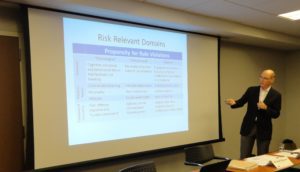
Dr. R. Karl Hanson, Senior Research Officer with Public Safety Canada, leads a discussion about actuarial risk scales.
Over two days in late August, twelve leading international researchers, scientists, and developers of offender risk and need assessment instruments met in Washington, D.C. to review current assessment instruments and discuss how the field can develop consistent definitions to use across multiple assessment tools and among correctional agencies, the judicial system, and program providers, as well as in research and academia. The event, “Common Language for Risk Communication Convening,” was hosted by the National Reentry Resource Center (a project of the Council of State Governments Justice Center that is administered by the U.S. Department of Justice’s Bureau of Justice Assistance) and highlighted the field’s need for a common, consistent language for risk assessment measures.
Experts at the event, facilitated by Dr. R. Karl Hanson and Dr. Guy Bourgon from Public Safety Canada, debated the challenging task of developing non-arbitrary definitions for actuarial risk scales.
“The biggest challenge is that there aren’t any standards across risk and need assessment tools and jurisdictions,” said Dr. Faye Taxman, from George Mason University’s Center for Advancing Correctional Excellence (ACE!). “For example, there are no standard definitions of ‘low,’ ‘moderate,’ or ‘high risk,’ even though these terms are used frequently.”
The underlying constructs of risk scales and classifications were a focal point of the discussion, which included some deliberation over the number of risk categories that should exist and the definitions for each category. Some participants expressed concern about how the field will react to the changes to current definitions and classifications of risk assessment instruments, though all agreed it is time to carefully examine the issue.
“This is a serious issue, and we don’t have an easy resolution,” said Dr. Hanson. “It’s hard to change people’s minds, but it is in the best interest of the field, of the individuals being assessed, and of the community to improve our risk communication.”
The event marks the first of a series of meetings that will focus on establishing theoretically sound common risk and need thresholds across risk scales, and connecting the categories to quantitative indicators. The meetings are guided by a number of goals, including improving predictive accuracy and risk communication among evaluators, professionals, decision makers, administrators, and practitioners; advancing collaboration and communication by developing a shared language around risk of criminal activity and public health needs; and establishing common priorities across correctional, treatment, and programming agencies to promote effective practices.
There are a number of practical implications that support improved and consistent risk communication, such as delivering the correct dosage of treatment and ensuring that the right intervention and treatment programs are delivered to meet an individual’s specific needs. Consistent scales and classifications in risk assessments will assist with establishing agreements on questions such as who to treat, what treatment(s) and/or intervention(s) to use, how much of each treatment and/or intervention an individual needs, and the duration of each treatment and/or intervention.
“Good assessment is the beginning of good rehabilitation,” said Dr. Robin Wilson of Wilson Psychological Services LLC in Sarasota, FL. “We assess risk because we are in the public safety business…If we are going to pay attention to people, we want to pay attention to the right aspects.”










